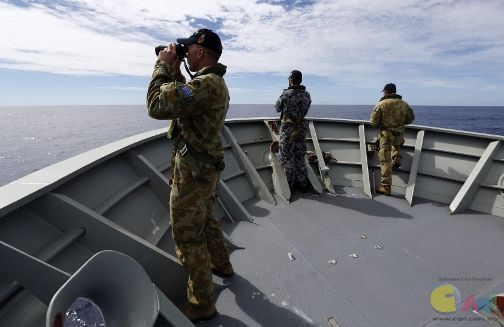 PERTH, April 10 — The search for missing Malaysia Airlines flight MH370 may be using some of the world’s most sophisticated tools, but some decidedly low-tech gear still has a major role in cracking one of modern aviation’s great mysteries. While the US Navy’s P-8 Poseidon surveillance plane scours the Indian Ocean below with top-secret cameras and sensors, older technologies, such as sonobuoys, as well as divers and human eyesight, are emerging as crucial to the operation. “With all the technology we have, nothing is as important as looking at things with your eyes,” US Navy Lieutenant Ken Savage told Reuters during a recent search flight on one of two Poseidons helping with the multi-national effort. The Malaysia Airlines Boeing 777 jetliner vanished on March 8 en route from Kuala Lumpur to Beijing, carrying 227 passengers and 12 crew. In the most expensive search operation in aviation history, neither satellite nor sensor has yet found any wreckage. That’s where the human factor comes in, says David Mearns, a deep sea search and recovery expert who was involved in the search for Air France Flight 447, which crashed in the Atlantic Ocean in 2009. “Even though it may look simple and rudimentary compared to the undersea work, it’s still very important,” he said, referring to the visual searches that are key to the mission. “At the end of the day, it’s left to eyes on water and men and women to be able to pluck wreckage out of the sea. Those methods are still extremely valid.” Keep quiet out there A sophisticated US Navy “Towed Pinger Locator” (TPL) has recently picked up four “pings” consistent with black box locator beacons, helping to narrow the search area and inspiring fresh confidence in the search. But the deep ocean is a very noisy place, prompting Australia this week to deploy a World War II-era technology, the sonobuoy, to help the TPL search for the black box recorders. All 84 sonobuoys are equipped with a hydrophone listening device, which is dangled some 1,000 feet (305 metres) below the surface and can transmit data to search aircraft via radio signals. Crucially, the sonobuoys are quiet where higher-tech search planes and ships might interfere with the delicate task. “That does provide a lot of sensors in the vicinity of the Ocean Shield without having a ship there to produce the background noise,” said Commodore Peter Leavy, the operational head of the Australian search, referring to an Australian Naval vessel helping in the search. The Australian Navy has this week released photographs of divers working alongside the Ocean Shield, which is carrying the TPL. While the TPL may have futuristic listening capabilities that allow it to hear far better than the human ear, it lacks what may be the most important tool for when debris is finally found: hands. “There are divers from the Royal Australian Navy in the search area for this specific purpose,” US Navy Captain Mark Matthews told Reuters. — Reuters
|
ADVERTISEMENT